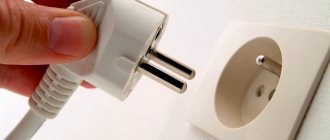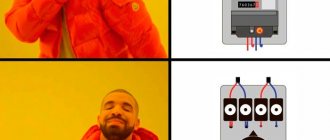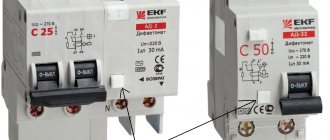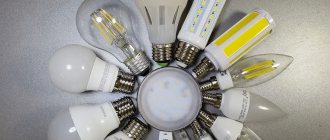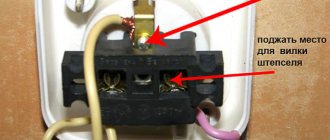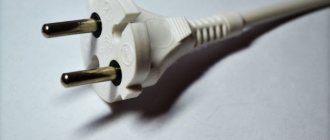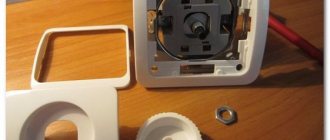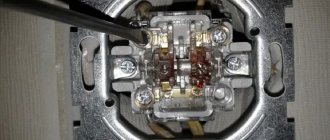Local overheating of electrical connections is often caused by poor contact. To more accurately determine the malfunction, you need to observe whether the outlet always heats up or only when the electric heating element is turned on. Heating of the plug connection due to high power consumption is an obvious sign of poor contact condition. If heating occurs regardless of power consumption, there may be a drop in resistance caused by wet wiring inside the household appliance. Since all conductive elements of the plug and socket are made of alloys with high thermal conductivity, heating spreads very quickly. In this case, the source of high temperature may be one of the weak points of the plug connection.
Why does the socket on the washing machine get hot?
In order to prevent short circuits, burnt wires and thereby prevent damage to household electrical appliances, it is necessary to regularly check the condition of the sockets.
After all, it is always easier and cheaper to prevent a minor breakdown than to later pay for your sluggishness not only with money, but possibly with your health. If the outlet is heating up, then you should not hope that the reason for this will simply disappear, without outside intervention.
Heating of the outlet can be caused by various reasons, including:
- Excessive power of electrical appliances connected to the outlet.
- Unstable contact of the plug inside the socket.
- Malfunction of the connectors inside the socket.
- The contact of the socket clamp is not tight enough.
Poor contact connections
This is the most common cause of heating. If all the previously described problems are excluded, you will have to disassemble the device body and check the contacts. Be sure to check whether the screws securing the wiring are securely clamped.
When the design of the socket does not provide for the presence of springs, the plug is not tightly “clasped” by the contacts. If you don’t have time to set a new point now, you can try to press the “clicks” of the device closer to each other. However, they will soon weaken again and the problem will recur. Therefore, it is better to immediately find the time and, instead of the old one, install a socket with springs. Then, when you turn on the machine, the device body will not heat up.
What is the reason
In most cases, sockets burn out due to multiple excess power of various electrical appliances that are connected to it. You should know that on the body of any outlet there is relevant information in numbers that helps solve the problem before it occurs. You just need to know the power of electrical appliances connected to the network and compare these numbers with those indicated on the outlet.
If several devices are simultaneously connected to one outlet, this will certainly cause an overload, the resistance will rise and the outlet will begin to heat up quickly. To prevent heating of both the plug and the outlet itself, it is important to control the extent to which power sources are loaded.
Often, the reason for an insecure connection between the socket and the plug is the unsatisfactory fixation of the plug with the connectors inside the socket. Old-style plugs from the times of the USSR are still very common, but their electrodes are almost a millimeter thinner than the electrodes of modern sockets, and the electrodes themselves are located at the same distance on both types of sockets.
Exceptions!
So I'll make an amendment to the article. There are cases in which the socket will heat up and melt regardless of whether the terminals are tightened well or poorly, whether the plug is tightly seated in the socket, and so on. This case is called “overload” of the network, when the power consumption of an electrical appliance exceeds the permissible limit that a given outlet group can withstand. Let's say we have old aluminum electrical wiring, it suits us. But the trouble is, when you plug in an automatic washing machine, the outlet immediately begins to heat up and then spark, even though it seems like a new one was installed recently. My tips for eliminating the simple problems mentioned above will not help here. Here we can only help by laying a dedicated line from the switchboard to the washing machine. I have written this more than once in other articles and am ready to repeat it. This list also includes air conditioners, dishwashers, and electric stoves. I even dedicated this article to connecting electric stoves!
The plug must be compatible
You need to be careful and not try to connect a Soviet plug into a modern socket: this will certainly cause it to heat up, due to the guaranteed weak contact with the connectors inside the socket.
If the socket is subjected to frequent mechanical stress, that is, the plug is often removed and inserted, then the socket connectors quickly fail and cannot sufficiently fix the electrodes. This also causes the outlet to heat up.
Probably the best wire material to use for wiring is copper rather than aluminum. And the point here is not electrical conductivity or resistance difference. The fact is that aluminum has one drawback: it is very plastic and, over time, tends to leak out from under the contact clamps. This weakens the screw clamp and inevitably causes the socket to heat up.
How to fix the network connection point
Heating of the device, a burning smell, and the appearance of sparks even under normal load indicate that the device should be disassembled to determine the cause of the malfunction. And then the cause must be eliminated.
- Turn off the electricity supplied to the suspicious connection point. This can be done by turning the handle of an old bag, unscrewing the plugs, or using automatic fuses.
- Check the presence of voltage in the network after disconnection. Use an indicator screwdriver or a work desk lamp. After making sure that the light does not come on, proceed to disassembly.
- Remove the cover from the device.
- Loosen the screws of the tabs that secure the operating mechanism in the socket. Carefully remove the interior and wires for further analysis.
When inspecting the device, the following faults are most often found:
- The clamping of the power supply cores that connect the distribution mechanism to the wiring in the room has become loose. This damage is more common with soft aluminum conductors. Their ends should be inspected and crumbled parts should be removed. Remove insulation from about 9 mm of the entire wire. Secure them with clamps and assemble the socket. If the wires are copper, you need to tighten the clamp screws using a screwdriver.
- Deformation of the contact plates located in the device sockets. It is a consequence of plastic melting when the load is exceeded. A socket with such a breakdown must be replaced.
- If the device is a pass-through device (that is, the next one comes from it), then even without the plug on it can heat up. The product should be disassembled and the clamps and plates checked. After correction, assemble and check the quality of work.
Eliminate Heat
Before you begin to troubleshoot any problems associated with electrical appliances, you must first stop the current supply to them. To achieve this, you need to turn off the machine, or unscrew the plugs on the electrical panel, after which the cover is removed from the socket, which is secured with a screw in the central part of its body.
If it is noticeable that the contact wires have been exposed to high temperatures, then this is the reason for the heating of the socket. To bring them back to normal, you need to completely remove the socket from its socket, after loosening the screws that secured it. After this, clean the contacts and place them back into the contact clamps, properly tightening the mounting screws. Then the socket is assembled and installed in its place.
Load determination using wire cross-section
To check the wiring capabilities and determine the maximum load for a specific electrical network, you need to find out the cross-sectional area of the wire and perform calculations:
- First, you should determine the diameter of the core using a caliper. The actual cross-sectional area is found using the formula: Sф.=0.785*D2. Instead of “D”, substitute the measurement result.
- To calculate the specific current and power, you must find the difference between the maximum and minimum values in the interval in which the calculated cross-sectional area falls. The difference in specific current strength is divided by the difference in cross sections in the same interval, where the smaller value is index 1, and the larger value is index 2, namely Isp. = (I2-I1)/(S2/S1). The value is obtained in A/mm2. Specific power is found in a similar way: Nsp.=(N2-N1)/(S2/S1). The required current and power values are calculated using the formulas: Isq.=(Sph.-S1)*Isp.+I1 and Nsq.=(Sph.-S1)*Nsp.+N1.
If the values obtained in the calculations are less than those indicated in the instructions for electrical appliances, the cause of heating is weak electrical wiring.
Why does the plug from the extension cord in the socket heat up when the water heater is turned on?
Features of a household network. Let's learn electrical installation... Everything a self-taught electrician needs to know. Self-instruction manual. Features of household lighting…
We make safe wiring. How does a differential device work... How to ensure the safety of electrical wiring? Automation. Electric automatic,…
Laying the electrical wire. How to select and lay wiring with... How to choose an electrical wire? Its choice, types, types, classification. Gasket…
Why does it generate electricity from water pipes, taps, faucets?... Why can it generate electricity from water pipes, taps? Causes of electric...
Why does a wooden floor squeak... My practical experience in dealing with floor squeaks. And also advice from old people. How do I get off...
The heating stove is an original stove design…. An interesting design of a heating stove with adjustable room heating...
Poor tightening of screws in the socket
As a rule, the main cause of this type of malfunction is weak electrical contact at the points where the cable cores are connected to the socket terminals. Before carrying out repairs, it is necessary to remove the voltage from the supply line or turn off the entire apartment. Then you should remove the plastic cover of the socket: it is secured with one or two small bolts. The socket mechanism must be removed from the installation box. To do this, you will need to unscrew a pair of side screws that secure the metal case to the socket box, then loosen the crab clamps by releasing the two recessed bolts located on the sides of the socket mechanism. After removing the mechanism, you need to carefully inspect the connection point of the electrical wires for carbon deposits or poor tightening. The best solution would be to make the connection again, after first stripping the cable cores to a metallic shine.
What to do if the connection device catches fire
What to do if an outlet catches fire is a question that everyone should know the answer to. In a moment of danger, it is easy to get confused, but urgent and adequate actions are needed. The cause of a sudden fire may be incorrect installation of the connection device, breakdowns inside the mechanism, as well as incorrect operation of the product.
How to extinguish an electrical outlet fire
Due to a malfunction or short circuit, the socket caught fire, what should people who are in this room do? Remember. You can extinguish a connection point that is energized using special fire extinguishers:
- carbon dioxide;
- powder;
- chemical foam (air emulsion).
Attention! When using a carbon dioxide fire extinguisher, do not touch the metal parts of the device with bare hands. A decrease in carbon dioxide pressure causes a sharp drop in temperature, and therefore threatens a person with frostbite on his hands.
Dry earth and sand will replace the special agent, but will be less effective; try to put out the flame by covering it with a piece of dense natural textile. Do not use water under any circumstances; it is dangerous when extinguishing electrical appliances.
Don't have the type of fire extinguishers you need nearby? Then proceed according to the following algorithm:
- Assess the scale of the incident. If smoke or sparks appear in the area of the outlet, turn off the electrical appliance as quickly as possible. Under no circumstances should you grab the electrical cord or wires directly with your hands.
- If you are in a familiar room and know where the electrical panel is located, turn off the electrical power - unscrew the plugs or turn off the switch.
- If you are in an unfamiliar room, you should interrupt the power supply to the device in a dangerous place. Use pliers with rubber handles or cut the wire with an ax with a dry wooden handle.
Be sure to call an electrician, describing everything that happened at the scene.
What to do if the socket is on fire and the fire and smoke spread quickly? Do not try to isolate such a problem yourself. Quickly take the documents and leave the premises along with other residents of the house/office employees. After urgently calling a special service, wait for the fire brigade to arrive.
